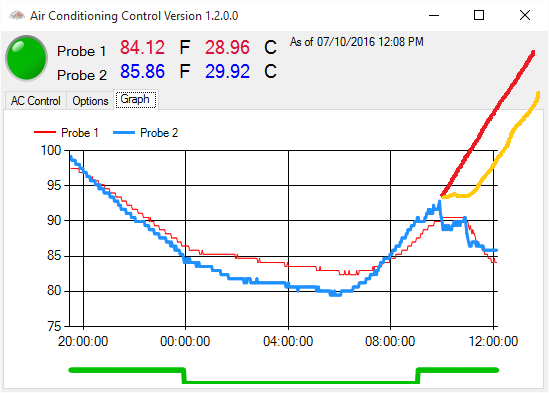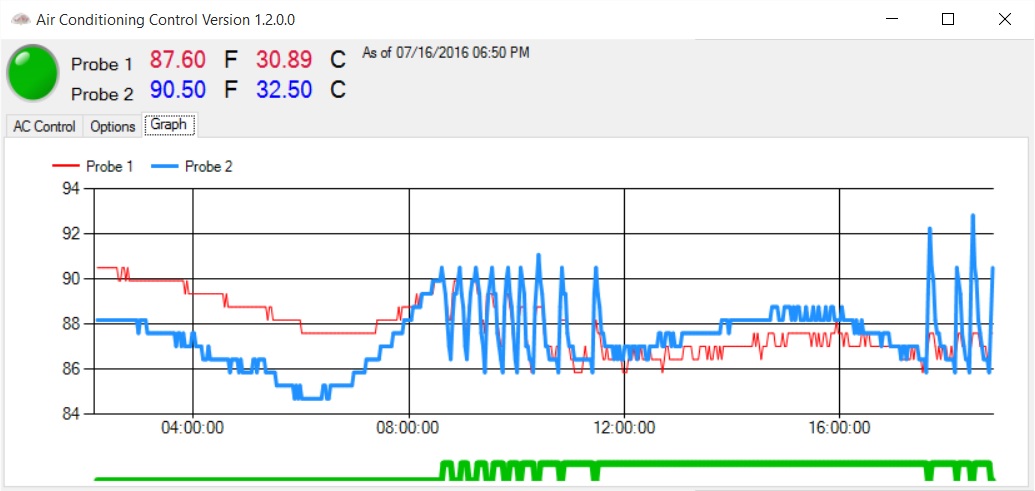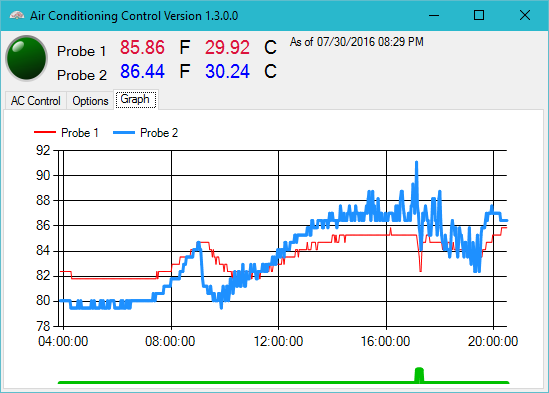I installed a small 8000 BTU window air conditioner in the dome several years ago to keep the dome cool during the summer. I am concerned about the dome getting so hot in our 115 degree heat that the electronics will be damaged (computer, power controller, mount, …).
As described in an earlier entry, I built an Arduino based temperature probe and wrote a little program ACCycle to turn the air conditioner on and off.

This has been working OK, but the AC is clearly unable to keep up. As the image above shows, no air conditioning would generate the red line. The orange line shows the typical response to the single unit coming on; it lowers the temperature in the dome by 5-10 degrees, but otherwise follows the ambient.
So, I bought a second 8000 BTU unit. This one is a portable unit with the big hose that exhausts out the window. The blue data shows the result of both units turning on – the temperature immediately lowers back to the target 85 degrees.
Not So Simple
First, it is clear that the two units together work very well. Now, instead of seeing the dome temperature follow the outside temperature (but a few degrees cooler) I can see the AC units kicking in and bringing the temperature back down to 87. I have it set to start cooling at 90, stop at 87. In the image below the dome temperature (blue line) rises steadily in the morning. About 8:30 it hits the upper limit of 90, at which point the two units kick on. They quickly cool back below 87, at which time they shut off. The units cycle until about noon; at that point the heat is enough that the units stay on steadily until about 5:00 PM, when it starts cycling again.

But – I am encountering power problems, which I have never had to think about before.
Surge Protector Limit
To start, my Power Controller is plugged into a big surge protector, which in turn is plugged into the wall. When the two AC units are turned on, the power exceeds the surge protector limit. The surge protector shuts off, including power to the computer and everything. I have to reboot the system and start everything again. Doesn’t happen every time, so I am apparently close to the limit of the surge protector.
Power Controller Problem
So, my next step is to plug the power controller directly into the wall, bypassing the surge protector. In addition, the controller has an “A” and “B” side, each allowing 15 amps. I had been running both AC units from one power cord on the “B” side. Now I plug one AC into the “A” side and the other into the “B” side.
Well, it is better, but every so often ACCycle turns the AC on but they don’t actually turn on! I think the surge through the Power Controller is problematic somehow. I have trouble reproducing the problem, but is seems to happen a couple of times a day. Unfortunately, it can end up in a state where the AC is off, but ACCycle thinks it is on. Thus, the dome keeps heating up.
Shadow AC
Next approach – get around having both units turning on simultaneously.
One approach would be to put the two units on separate ports in the Power Controller and have ACCycle control both units. However, I don’t have any extra ports in the Power Controller. I could buy another controller:(
Instead, I put one unit on a manual timer on the wall socket. This timer will turn on the AC at 9:30 in the morning and turn off at 7:30 at night, after sundown. At this time of year there aren’t any days where cooling isn’t needed, so this is reasonable.
Now ACCycle only controls the second unit. It only kicks in when the first unit cannot handle the load. Both units don’t necessarily run, and they don’t kick on at the same time. In the image below the first unit started at 9:00 AM. It was a cooler day (only reached 101) so the second unit wasn’t needed until late in the day about 4:30 PM. It kicked in briefly when the temperature got above 90 and quickly brought it under 85, at which point it wasn’t needed any more.

